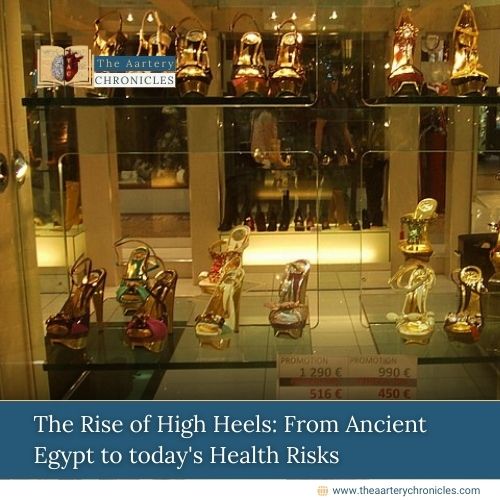

The Rise of High Heels: From Ancient Egypt to today's Health Risks
What are high heels?
High heels are a fashion staple and a symbol of elegance. Its fascinating history has spanned cultures, centuries, and continents. Originally invented for men for a distinct purpose, high heels now have become the emblem of femininity, sophistication, and grace.
Over time, high heels have significantly transformed in the aspects of their designs, purpose, and social significance. Heels are a fashion statement today and have become increasingly popular among women from approximately all age groups for several reasons including aesthetic appeal, fashion versatility, the influence of media and celebrities, cultural norms such as business settings, corporate and formal events, etc.
Origin And History Of High Heels
The origin of heels can be traced back to 3500 BCE, during the ancient civilizations of Egypt. At the time the first heels were worn by the butchers. These high heels because of their elevation helped walk easily on slaughtered animal bodies and bloody floors without getting the feet dirty. A few ancient murals from Egypt show figurines wearing high heels during the ceremonial processes.
Around the late 15th century high heels were used solely for their functionality. Persian soldiers used heels to secure their feet in stirrups. The horsemen used shoes with fitted heels at the time as they offered a firm grip on stirrups. This development is the real source of the first trend.
Furthermore, in the late 16th century, high heels became a significant component of male fashion in the West. Persians brought high heels when they arrived in Europe for political alliance or some sources also mention their migration. Male aristocrats in Europe used heels to look formidable and taller.
During the late 15th to early 17th centuries, women in Venice had started wearing pedestal-like chopine which sometimes went as high as 54 cm. In France, the chopines were outlawed for several reasons. Louis XIV of France is considered a fashion maven of that time associated with red-painted 4-inch heels that underwent a fall post-French revolution.
Then came the Victorians who rediscovered the heels, however by the time the men’s hold on the heels was broken. During the Victorian era, the picture of a woman wearing a few inches of heel featured in most ‘French Postcards.’ In the 18th century, the masses started associating heels with femineity and made it a significant aspect of a desirable noblewoman’s body. Later, several types of heels and shoes came along the way.
Through the late 19th -20th century, the Stiletto the narrowest heel came to be which was named after an Italian dagger of the Renaissance period. Today there is a wide variety of heels available all over the market and high heels continue to be popular with global business valuing around USD 5620.97 million according to the 2022 data.

Health effects of high heels
- Arthritis: According to the experts, frequent use of high heels can change the walking pattern of the wearer. An individual who uses heels regularly tends to take forceful and shorter strides rather than those with use flats and shoes. These types of walks can put extra strain on the joints of the knees which may lead to an increased risk of osteoarthritis. Prolonged use of heels may cause early arthritis.
- Balance issues: When an individual wears heels their overall body weight and gravity center get shifted to compensate for the heel. It can be highly cumbersome to balance when walking on tiptoes, especially in the case of heels like stilettos where the heel of the footwear is narrower than the foot.
- Joint Pain: Prolonged heel usage interferes with the biomechanics of the body. Increased weight on the joints can make them painful as the weight shifts in front putting excess load on joints including knees and hips. The risk of hip, knee, and lower back issues is proportional to the height of the heel. The higher the hell the greater the risk of developing these issues.
- Claw toe: Regular use of heels can lead to claw toes and hammertoes among other deformities including bunions, calluses, and corns. This is caused because of the constant friction and pressure from the footwear. Hence, the toes get bent in unnatural positions.
- Ankle sprains and Spine: A few studies suggest that the risk of getting sprained ankles is around 40% higher in people using high heels regularly. Frequent sprains can cause unstable and weak joints. High heels also put pressure on the lumbar erector spinae muscle resulting in spine damage in the long term.
- Toes Overlapping: Usage of high heels regularly can cause crowding of toes which leads to overlapping. Overlapping may result in abrasion on the finger sides and the back of the feet may get severely damaged. Moreover, using such tight-fitting footwear impedes the circulation of the blood and results in numbness, and swelling, and increases the risk of varicose veins.

Sanika Pande
- Medicine
- Nutrition And Diet












